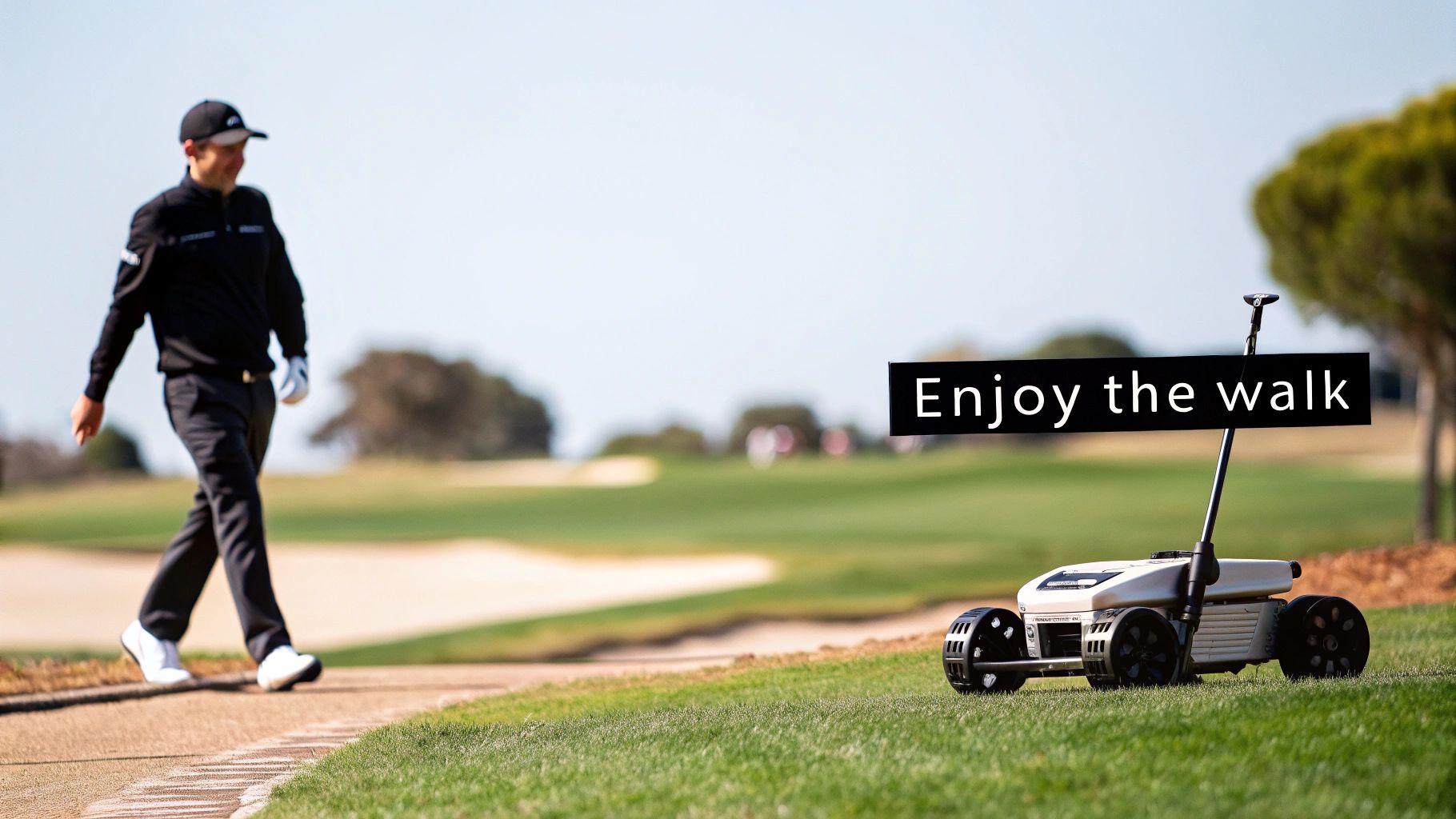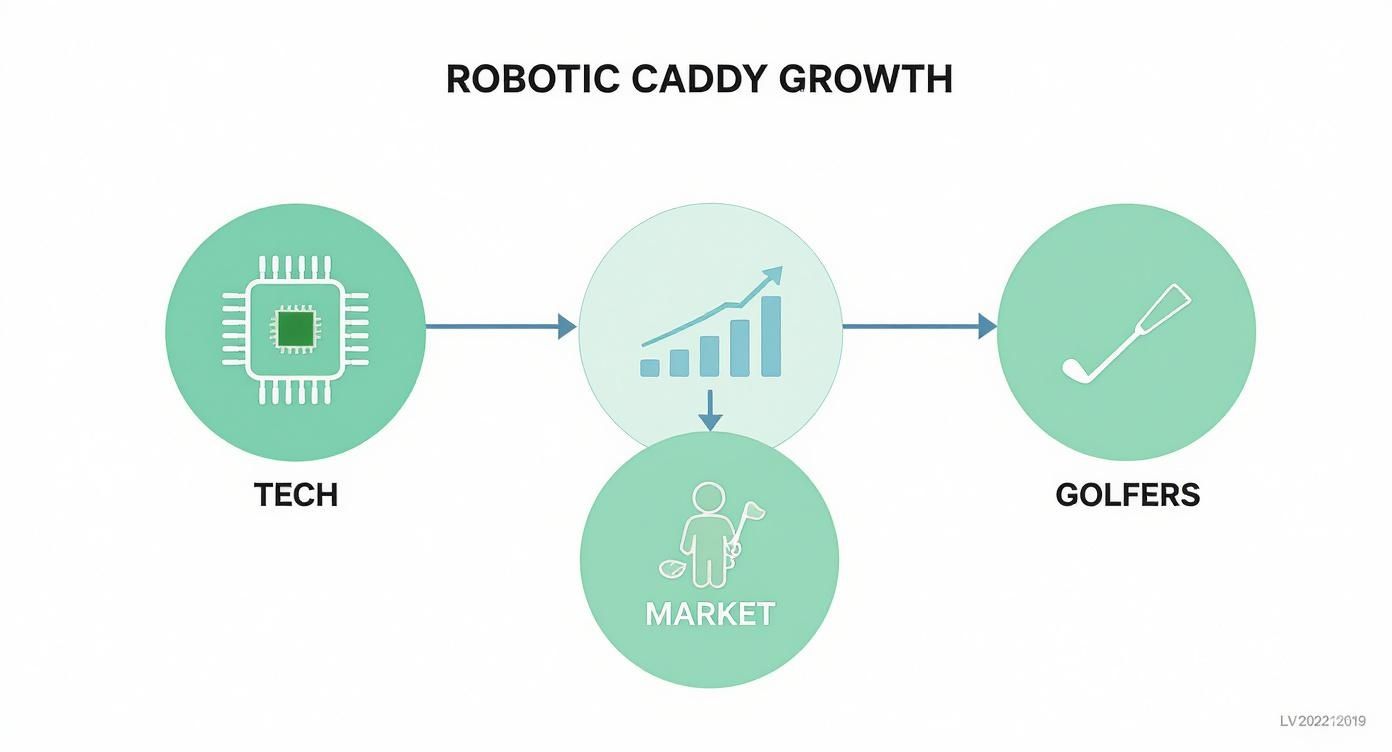Picture this: you’re walking the fairway, completely dialed in on your next shot, while your clubs glide silently right beside you. That’s the magic of a robotic golf caddy. It's a smart, self-propelled cart that follows you around the course, completely taking the hassle of carrying, pulling, or pushing a heavy bag out of the equation. This guide is all about how this tech blends the classic tradition of walking the links with some seriously cool modern convenience.
The Future of Walking the Fairway Is Here
For decades, golfers really only had two choices: haul their own bag and wear themselves out over 18 holes, or hire a caddy. Push carts helped, sure, but they still took a lot of effort, especially when you hit a hilly stretch of the course. The robotic golf caddy is the next logical step in the game's evolution, giving you a truly hands-free round that keeps all the health benefits of walking without any of the physical drain.

This isn't just about making things easier; it's about getting your focus and energy back for what actually matters—your game. When you offload the physical work of managing your clubs, you can pour all that mental and physical energy into every single swing.
A New Era of On-Course Freedom
Think of a robotic caddy as your personal assistant out on the course. It doesn't just tote your clubs around; it frees you up to completely immerse yourself in your surroundings and the strategy of the game. Their growing popularity is part of a bigger trend where smart tech is making golf more accessible and fun. Golfers are jumping on tools that get rid of the tedious stuff, making for a smoother, more enjoyable round.
Here are a few key benefits driving this shift:
- Reduced Physical Fatigue: Save your energy for your swing, not for shoving a cart up a steep fairway.
- Improved Focus: Keep your mind on picking the right club and managing the course instead of wrestling with your gear.
- Enhanced Enjoyment: You can actually appreciate the walk, the scenery, and the company without being weighed down by a bag.
This technology lets players get all the health perks of walking the course without the exhaustion, which ultimately leads to better performance and a more enjoyable round from the first tee to the final green.
As these caddies get more advanced and affordable, they’re shifting from a luxury item to an essential piece of equipment for any serious golfer. It's a lot like having a dedicated caddy, but with the steady, reliable performance of modern engineering.
To see how this tech is being used across different models, check out our guide on the ultimate 2025 golf buggy that follows you for a detailed comparison. It’ll set the stage for understanding how these machines work and why they're quickly becoming a common sight on courses everywhere.
Why Robotic Caddies Are Taking Over the Course
The switch from a manual push cart to a modern robotic caddy feels a lot like the jump from flip phones to smartphones. At first, it might seem like a luxury, but once you try it, you realize it’s an essential tool that completely changes how you experience the game. This exact shift is happening on fairways everywhere as more and more golfers discover the massive advantages of having an autonomous assistant.
So, what’s fueling this takeover? It’s the perfect blend of smarter technology and what golfers now expect on the course. A new generation of players is used to smart devices in every other part of their lives, and they’re bringing that same expectation to their favorite sport. They don't see a robotic caddy as just another gadget; they see it as a practical upgrade that helps them play better and have more fun.
The Technology Driving the Trend
Let's be honest, older electric trolleys had their issues. They were often held back by clunky batteries and basic, unreliable controls. Today's robotic caddies are a different breed entirely, powered by huge leaps in a few key areas.
- Better Battery Life: Modern lithium-ion batteries are lighter, last longer, and recharge way faster. They can easily handle 36 holes on a single charge, so you never have to worry about running out of juice mid-round.
- Precision GPS: High-accuracy GPS and advanced sensor tech allow the caddy to follow you perfectly, without veering off into a bunker or lagging behind. It just works.
- Smart Sensors: Forget worrying about collisions. Advanced obstacle avoidance systems keep the caddy from running into trees, other players, or your buddy's brand-new driver. It ensures a smooth, safe round every time.
This combination of reliable power and built-in intelligence has cemented the robotic caddy's place as a must-have piece of modern golf equipment. The market data tells the same story.
The global market for autonomous golf caddies is exploding, projected to hit around $500 million in 2025. This growth is set to continue at a compound annual growth rate (CAGR) of about 15% from 2025 to 2033, driven by golf's rising popularity and the demand for tech that just makes life easier. You can read the full research on emerging golf technology trends at Archive Market Research.
This isn't just a niche trend anymore; it’s a fast-growing slice of the multi-billion dollar golf industry. When your robotic golf caddy is handling the heavy lifting, you can save your physical energy and stay mentally sharp from the first tee to the eighteenth green. That enhanced focus and reduced fatigue give you a real edge, and it’s an advantage golfers at every skill level are eager to get their hands on.
Key Features That Power a Smart Caddy
So, what really separates a sophisticated robotic golf caddy from a simple electric trolley? At first glance, they seem similar, but the difference is night and day. It all comes down to a handful of intelligent features that create a truly hands-free day on the course. While both use motors, a robotic caddy acts more like a personal assistant who’s always one step ahead.
It all begins with how the caddy moves. A proper robotic caddy is driven by powerful, often dual, motors that have enough torque to tackle hills and uneven fairways without breaking a sweat. These aren't just basic on/off engines; they offer variable speed control, which allows the caddy to perfectly match your walking pace. But the real powerhouse behind this is the advanced battery technology. If you want to dive deeper into what makes these batteries tick, you can check out our complete guide to electric trolley batteries.
The Brains Behind the Operation
Beyond the brawn of the motor, the true magic lies in the caddy's "brain"—a smart combination of sensors and software that lets it move all on its own. This is where the most impressive technology shines.
- Follow Me Technology: This is the headline feature. You clip a small remote to your belt or pop it in your pocket, and the caddy locks onto your position, following you at a set distance. It’s like having an invisible leash connecting you to your clubs.
- Obstacle Avoidance Sensors: Using ultrasonic or infrared tech, these integrated sensors are constantly scanning the path ahead. They spot hazards like trees, sand traps, or even another golfer, and automatically steer the caddy to avoid a collision. It's peace of mind for your expensive gear.
- GPS and Course Mapping: The top-tier models use pinpoint-accurate GPS to know exactly where they are on the course. This isn't just for navigation; it can sync with golf apps to give you yardage information, helping you make smarter club selections.
This tech has effectively split the market in two. As one analysis points out, you have motorized electric caddies that still need manual control, and then you have true robotic caddies that use AI and GPS to operate autonomously.
The infographic below really puts the growth drivers for robotic caddies into perspective, from the tech advancements to the growing demand from golfers like us.

You can see how better technology, rising market interest, and more golfers adopting these caddies are all connected, pushing this evolution forward at a rapid pace.
From Manual Labor to Smart Automation
To really appreciate the jump we've made, it helps to see how we've been hauling our bags over the years. The evolution from a simple push cart to a robotic sidekick shows a massive shift in what we expect from on-course convenience.
Evolution of Golf Carts From Manual to Robotic
This table breaks down the journey from pure physical effort to complete hands-free automation.
| Feature | Manual Push Cart | Electric Trolley | Robotic Golf Caddy |
|---|---|---|---|
| Propulsion | Player Pushes | Motorized (Manual Control) | Fully Autonomous (Follows) |
| Control | Handlebar | Remote/Handle Controls | Remote Signal & Sensors |
| Navigation | User-Steered | User-Steered | Self-Navigating |
| Hands-Free | No | No | Yes |
This progression isn't just about convenience; it's about minimizing the physical and mental load on the golfer. When you don't have to think about pushing, pulling, or steering, you can dedicate 100% of your focus to your next shot. The robotic golf caddy is the peak of this evolution, turning the simple act of walking the course into a genuine strategic advantage.
How a Robotic Caddy Improves Your Golf Game
Beyond the cool factor of the technology, how does a robotic caddy actually improve your round? The benefits go way beyond just not having to carry your bag. They touch on your physical stamina, your mental game, and ultimately, your performance on the course. It’s a better experience for golfers at every single skill level.
The most obvious advantage is the massive reduction in physical fatigue. Walking 18 holes is fantastic exercise, but hauling a 30-pound bag adds a serious amount of strain to your back, shoulders, and legs. Over a four or five-hour round, that physical toll drains your energy, which can absolutely sabotage your swing mechanics on the back nine.
Conserve Energy for a Stronger Finish
Think of your energy on the course like a gas tank—it’s a finite resource. Every bit you spend pushing or carrying your bag is fuel you can't put into your swing. A robotic golf caddy is basically an energy conservation tool, saving your strength so your last swing feels just as powerful and controlled as your first.
This saved energy leads directly to better performance:
- Maintained Swing Speed: As you get tired, your swing speed is usually the first thing to go. By taking that physical burden away, you can keep your clubhead speed much more consistent throughout the entire round.
- Improved Core Stability: A fresher body means a more stable core during your swing. That translates to better balance and more accurate shots, especially when you’re trying to close out a good round.
- Reduced Risk of Injury: Let’s be honest, overdoing it by carrying a heavy bag can lead to strains and other nagging injuries. A robotic caddy minimizes this risk, helping you play healthier, more sustainable golf.
By the time you reach the final few holes, the difference is night and day. Instead of feeling worn out and just trying to make it to the clubhouse, you're physically ready to score well and end your round on a high note.
Sharpen Your Mental Game and Strategy
The perks aren't just physical. When you offload the chore of managing your equipment, you free up a surprising amount of mental bandwidth. You’re no longer dreading the next big hill or wrestling with a cart on a side slope. All that newfound mental space allows you to focus completely on strategy and hitting your shot.
On top of that, many modern robotic caddies come with smart features like GPS yardage built-in. This data helps you make much more informed decisions on club selection and your approach, essentially turning your caddy into a strategic partner. Instead of pacing off distances or guessing, you have precise information right there with you—a clear competitive advantage.
Ultimately, a robotic golf caddy just makes the game more fun. It lets you fully immerse yourself in the walk, the scenery, and the social side of a round without the constant distraction and physical drain of your gear. It brings the focus back to what really matters: playing your best golf. For anyone moving up from a manual cart, understanding what a push cart is and its limitations really drives home the massive upgrade a robotic assistant provides.
Bringing It All Together on the Green
The real test for any piece of golf gear isn't on a spec sheet—it's measured hole by hole, shot by shot, out on the course. To really get a feel for the impact of a robotic golf caddy, let's walk through a typical par 4 with a Caddie Wheel as our on-course partner. This is where you see how smart features translate into a better, more focused round of golf.

Picture yourself standing on the tee box. Instead of dragging your bag into position, your caddy glides silently beside you. With a simple remote clipped to your belt, your entire focus is on the fairway ahead. After you rip your drive, you just start walking. No pushing, no pulling—just a smooth, hands-free stroll as your caddy follows a few paces behind.
Navigating the Fairway with Ease
As you approach your ball, the real magic of a robotic golf caddy becomes obvious. You stop, and it stops. You grab your iron for the approach shot, and the caddy waits patiently. That seamless interaction is the core promise of "Follow" technology, turning what used to be a chore into something you don't even think about.
Now, consider a course with rolling hills and tricky terrain. This is where a well-designed caddy proves its worth. Models like the Caddie Wheel are built with powerful motors and excellent traction, effortlessly handling steep inclines that would leave you breathless with a manual push cart. You arrive at your ball feeling fresh and ready to execute your shot with precision.
A great robotic caddy doesn’t just carry your clubs; it conserves your most valuable on-course assets: your physical energy and your mental focus. This allows for a stronger performance from the first tee to the eighteenth green.
From Approach Shot to Final Putt
After your second shot lands near the green, you walk towards it, your caddy quietly tracking your path. It navigates around a greenside bunker without any input from you, all thanks to its intelligent design. You don't waste a single thought on maneuvering your gear—it's all handled for you.
This hands-off freedom is a huge reason for the rising demand for autonomous golf course equipment. Players are actively looking for labor-saving devices that improve the golf experience and let them focus purely on the game. You can find more insights on this growing trend in golf course technology on futuremarketinsights.com.
Once on the green, you can park your caddy and focus entirely on reading your putt. The intuitive remote makes it simple to stop, start, or reposition the unit with the push of a button. Even golfers who aren't tech experts find the controls straightforward and easy to master within just a few minutes.
This whole sequence—from tee to green—shows how a well-designed robotic golf caddy perfectly delivers on its promise. By removing the physical burden and mental distractions of managing your bag, it enhances every single moment of your round, letting you play your best and simply enjoy the walk.
Common Questions About Robotic Golf Caddies
Even with all the obvious benefits, dropping money on a new piece of golf tech is a big decision. It's only natural to have a few questions. Knowing how a robotic golf caddy actually performs out on the course is the key to feeling good about your choice.
Let's tackle some of the most common things golfers wonder about before they make the switch to a hands-free round.
How Do These Things Handle Hills and Uneven Terrain?
This is one of the first questions everyone asks, and for good reason. The answer comes down to smart engineering. Any robotic caddy worth its salt is built specifically for the wild landscapes of a real golf course. They come loaded with powerful dual motors that deliver more than enough muscle to climb steep hills without whining or slowing down.
To conquer those challenges, they usually feature:
- High-Traction Wheels: These aren't your standard push cart wheels. They're designed to grip wet grass and loose dirt, so you don't have to worry about slippage.
- Electronic Brakes: For those tricky downhill walks, an automatic braking system kicks in to control the caddy’s speed, making sure it never gets away from you.
- Advanced Stabilizers: Many of the best models use gyroscopic sensors to stay balanced on sidehills, keeping your expensive clubs from taking a tumble.
This trio of power, grip, and stability ensures your robotic caddy is a reliable partner, no matter how tough the terrain gets.
What Happens If the Remote Battery Dies or Loses Connection?
Losing control of your caddy in the middle of the 8th fairway is a nightmare scenario, but manufacturers have built-in plenty of backup plans. You’re never going to be left stranded.
The first line of defense is a simple low-battery light on both the remote and the caddy itself, giving you a heads-up long before it becomes an issue.
But if the remote does give out, nearly every robotic caddy has a manual mode. You can just grab the handle and guide it like a normal electric trolley. On top of that, most caddies have a "fail-safe" mode where the unit stops dead in its tracks if it loses the remote signal, so it won’t go rolling off into a bunker on its own.
Are Robotic Caddies a Pain to Set Up and Use?
While the technology under the hood is pretty sophisticated, the whole point is to make your life simpler. Most models are designed to be ready to go right out of the box. Assembly is usually just a matter of clicking the wheels into place—no tools required.
The goal of a robotic golf caddy is to reduce complexity, not add to it. The best brands focus on intuitive, user-friendly controls so that any golfer, regardless of how tech-savvy they are, can get the hang of it in the first couple of holes.
Pairing the remote is a one-time thing that’s as easy as connecting a Bluetooth speaker. After that, running it day-to-day is as simple as hitting a button to start, stop, or have it follow you down the fairway.
How Much Maintenance Do These Caddies Require?
Honestly, one of the best things about modern robotic caddies is how little you have to fuss with them. They are built from tough, weather-resistant materials designed to take a beating on the golf course.
Your main job is just taking care of the battery—charge it after each round and store it properly to keep it healthy for years.
Beyond that, the only other task is a quick cleanup. Wiping down the frame and clearing any grass or mud from the wheels is usually all it takes. The motors and electronics are sealed up and designed to be service-free, so you can spend your time playing instead of tinkering.
Ready to feel the freedom of a hands-free round? Caddie Wheel offers a simple, powerful, and affordable way to turn your existing push cart into a fully remote-controlled caddy. See for yourself how easy it is to walk the course with less effort and more focus by visiting Caddie Wheel's official site.


Share:
Your Guide to the Golf Electric Cart Caddy
Your Guide to the Golf Trolley with Battery